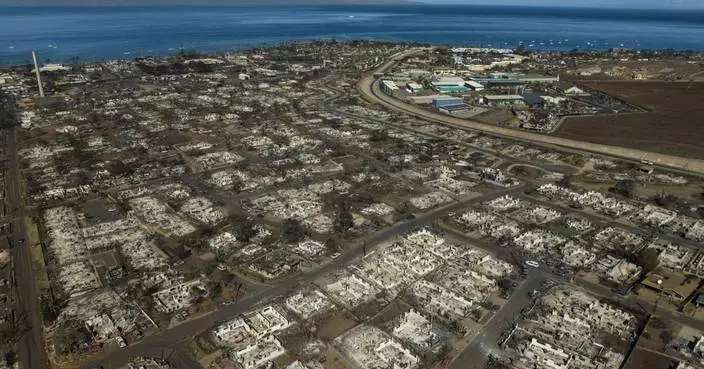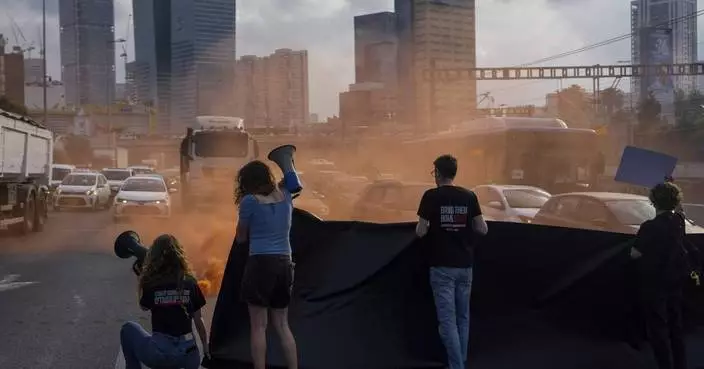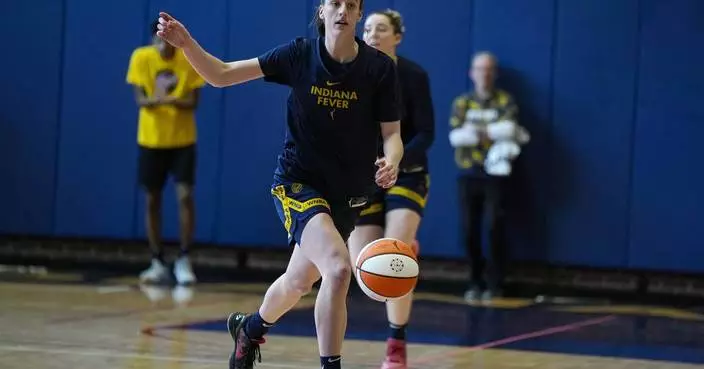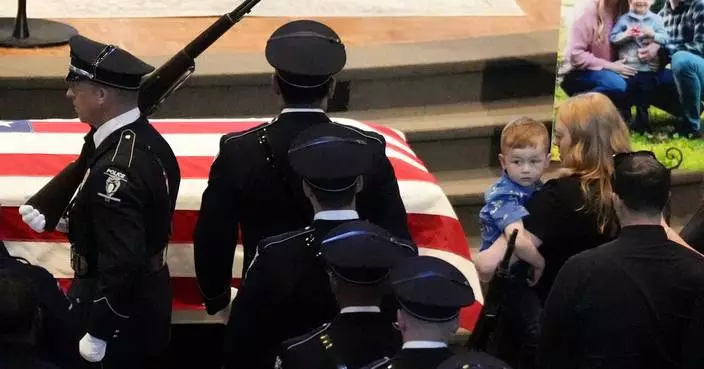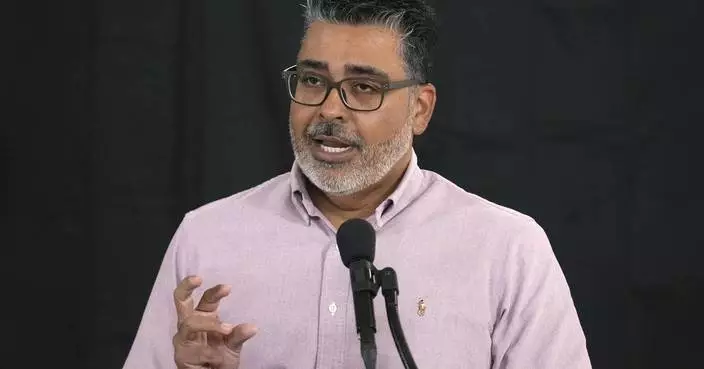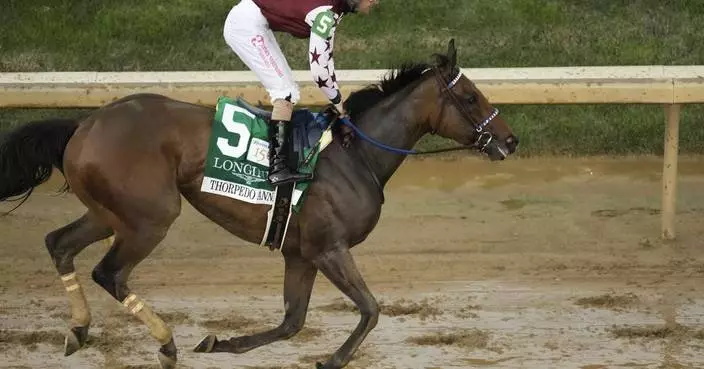AUGUSTA, Ga. (AP) — AP photographer Matt Slocum knows his way around the bucolic Augusta National Golf Club during the week of the Masters — it’s a difficult task with all the regulations that help preserve the aura of the tournament. So, when he saw the light and clouds combining for a perfect backdrop, he knew exactly where he should go to take some tee shots. He also knew how to stay ahead of the patrons to get to his perfect spot. Here’s what he had to say about making this extraordinary image.
The Masters is one of the most revered tournaments of professional golf — it’s also one of the toughest for photographers and golfers. One of golf’s four majors, it's full of history and tradition; rules and etiquette; joy and pain for both us and them.
Photographers are not allowed “inside the ropes” at the Masters — patrons are kept from the playing areas such as fairways and greens by ropes that mark the course. Being on the players’ side of the ropes give photographers better sight lines and ease of movement. But The Associated Press is lucky to have a good mix of photographers and editors onsite to help cover the tournament. We work together under the direction of David J. Phillip. With his vast Masters knowledge and experience, he guides us around the course as the day progresses and golfers charge up the leaderboard. Teamwork and communication are vital when covering this tournament. It’s tough to navigate the course quickly. You learn the hard way which crosswalks to avoid at peak times. Photographers that work together and are organized will have more success and less frustration overall.
Because we are not allowed inside the ropes, we tend to camp out at strategic spots and then leapfrog around before the crowds get too big. There are a few tee boxes that have access from behind. Patrons at the Masters are very polite and helpful when asked if we can kneel in front of them to get a key shot. By staying low, we don’t block them, and it allows us to emphasize the golfer and clean up the background. Once you find an area or light that is productive, you tend to work it, group after group to make scenic photos. You can vary the exposure and lens you use to add variety — wide, normal and telephoto.
In this case, golfers were teeing off toward the back of the box. I carried a fast, moderate-wide angle lens, a Sony 35mm F/1.4 GM and a Sony A1 mirrorless camera in anticipation of making this kind of photo. We are very lucky Sony is onsite to clean, repair and loan equipment. Not that I ever break anything, but many thanks to Van Nguyen, for replacing something I might have broken. I was shooting on a nearby hole when the clouds started to break and the blue sky appeared. This was my 14th Masters; I knew where to go in my area to line up a golfer with the sky.
I set my camera with the lowest native ISO, 100, to emphasize the dramatic sky. As golfer Rory McIlroy walked up the tee, I placed the camera very low and tried to keep him centered among the trees lining the hole. I just about always shoot at the widest aperture available, in this case F/1.4, to keep the emphasis on McIlroy. I was hunched way over on my knees, straining see the built-in level on the back of the screen. The camera was set to its fastest frame rate, 30 frames per second. I set the fastest shutter speed, 1/32,000th, to freeze all movement. I held the shutter release down for less than a second and made 22 crooked frames of the swing sequence. I picked a few visually pleasing moments to send to my editors Chris Carlson and Darron Cummings. It’s not obnoxiously crooked and has a nice feel, but it’s not perfect. “You can do better,” I hear from a ghost my head.
This photo is unique because of the clouds. There was a storm that delayed the start of the tournament that morning. It was dark and grey for most of the day. The shallow depth of field helps keep your eye focused on Rory. Using a very fast shutter speed helps make the bright areas of the image darker. It brings out the clouds, knocks down the crowd and freezes the golfer’s club at the top of his swing. The clouds are still breaking, framing the golfer and starting to add light on his swing.
For more extraordinary AP photography, click here.

Rory McIlroy, of Northern Ireland, hits his tee shot on the ninth hole during the first round at the Masters golf tournament at Augusta National Golf Club Thursday, April 11, 2024, in Augusta, Ga. (AP Photo/Matt Slocum)
WASHINGTON (AP) — A top U.N. official said Friday that hard-hit northern Gaza was now in “full-blown famine" after more than six months of war between Israel and Hamas and severe Israeli restrictions on food deliveries to the Palestinian territory.
Cindy McCain, the American director of the U.N. World Food Program, became the most prominent international official so far to declare that trapped civilians in the most cut-off part of Gaza had gone over the brink into famine.
“It’s horror," McCain told NBC's “Meet the Press” in an interview to air Sunday. “There is famine — full-blown famine — in the north, and it’s moving its way south."
She said a cease-fire and a greatly increased flow of aid through land and sea routes was essential to confronting the growing humanitarian catastrophe in Gaza, ilhome to 2.3 million people.
There was no immediate comment from Israel, which controls entrance into Gaza and says it is beginning to allow in more food and other humanitarian aid through land crossings.
The panel that serves as the internationally recognized monitor for food crises said earlier this year that northern Gaza was on the brink of famine and likely to experience it this month. The next update will not come before this summer.
One of the U.S. Agency for International Development's humanitarian officials in Gaza told The Associated Press that on-the-ground preparations for a new U.S.-led sea route were on track to bring in more food — including treatment for hundreds of thousands of starving children — by early or mid-May. That's when the American military expects to finish building a floating pier to receive the shipments.
Ramping up the delivery of aid on the planned U.S.-backed sea route will be gradual as aid groups test the distribution and security arrangements for relief workers, the USAID official said.
The official spoke on condition of anonymity over security concerns for work done in a conflict zone. They were some of the agency’s first comments on the status of preparations for the Biden administration’s $320 million Gaza pier project, for which USAID is helping coordinate on-the-ground security and distribution.
At a factory in rural Georgia on Friday, USAID Administrator Samantha Power pointed to the food crises in Gaza and other parts of the world as she announced a $200 million investment aimed at increasing production of emergency nutritional paste for starving children under 5.
Power spoke to factory workers, peanut farmers and local dignitaries sitting among pallets of the paste at the Mana nonprofit in Fitzgerald. It is one of two factories in the U.S. that produces the nutritional food, which is used in clinical settings and made from ground peanuts, powdered milk, sugar and oil, ready to eat in plastic pouches resembling large ketchup packets.
“This effort, this vision meets the moment,” Power said. "And it could not be more timely, more necessary or more important.”
Under pressure from the U.S. and others, Israeli officials in recent weeks have begun slowly reopening some border crossings for relief shipments.
But aid coming through the sea route, once it's operational, still will serve only a fraction — half a million people — of those who need help in Gaza. Aid organizations including USAID stress that getting more aid through border crossings is essential to staving off famine.
Children under 5 are among the first to die when wars, droughts or other disasters curtail food. Hospital officials in northern Gaza reported the first deaths from hunger in early March and said most of the dead were children.
Power said the U.N. has called for 400 metric tons of the nutritional paste “in light of the severe hunger that is pervading across Gaza right now, and the severe, acute humanitarian crisis.” USAID expects to provide a quarter of that, she said.
Globally, she said at the Georgia factory, the treatment made there “will save untold lives, millions of lives.”
USAID is coordinating with the World Food Program and other humanitarian partners and governments on security and distribution for the pier project, while U.S. military forces finish building it. President Joe Biden, under pressure to do more to ease the humanitarian catastrophe in Gaza as the U.S. provides military support for Israel, announced the project in early March.
U.S. Central Command said in a statement Friday that offshore assembly of the floating pier has been temporarily paused due to high winds and sea swells, which caused unsafe conditions for soldiers. The partially built pier and the military vessels involved have gone to Israel's Port of Ashdod, where the work will continue.
A U.S. official said the high seas will delay the installation for several days, possibly until later next week. The official, who spoke on condition of anonymity to discuss operation details, said the pause could last longer if the bad weather continues because military personnel and divers have to get into the water for the final installation.
The struggles this week with the first aid delivery through a newly reopened land corridor into north Gaza underscored the uncertainty about security and the danger still facing relief workers. Israeli settlers blocked the convoy before it crossed Wednesday. Once inside Gaza, the convoy was commandeered by Hamas militants, before U.N. officials reclaimed it.
In Gaza, the nutritional treatment for starving children is most urgently needed in the northern part of the Palestinian territory. Civilians have been cut off from most aid supplies, bombarded by Israeli airstrikes and driven into hiding by fighting.
Acute malnutrition rates there among children under 5 have surged from 1% before the war to 30% five months later, the USAID official said. The official called it the fastest such climb in hunger in recent history, more than in grave conflicts and food shortages in Somalia or South Sudan.
One of the few medical facilities still operating in northern Gaza, Kamal Adwan hospital, is besieged by parents bringing in thousands of children with malnutrition for treatment, the official said. Aid officials believe many more starving children remain unseen and in need, with families unable to bring them through fighting and checkpoints for care.
Saving the gravely malnourished children in particular requires both greatly increased deliveries of aid and sustained calm in fighting, the official said, so that aid workers can set up treatment facilities around the territory and families can safely bring children in for the sustained treatment needed.
Bynum reported from Fitzgerald, Georgia. Associated Press writers Lolita C. Baldor in Washington and Edith M. Lederer at the United Nations contributed.

USAID Administrator Samantha Power speaks with U.S. Rep. Austin Scott on Friday, May 3, 2024, during a tour of the factory where the nonprofit Mana produces emergency nutritional aid in Fizgerald, Ga. Power announced USAID is investing $200 million in emergency food aid for children in Gaza, Sudan and other countries where conflict has driven up need. AP Photo by Russ Bynum Sent from my iPhone

USAID Administrator Samantha Power talks with a worker Friday, May 3, 2024, during a tour of the factory where the nonprofit Mana makes emergency nutritional aid in Fitzgerald, Georgia. Power announced USAID is investing $200 million in emergency nutritional treatment for starving children as conflicts in Gaza, Sudan and elsewhere drive up the need. (AP Photo/Russ Bynum)

USAID Administrator Samantha Power talks with Mana operations director Harry Broughton during a tour of its factory in Fitzgerald, Ga., that produces emergency nutritional aid for starving children, on Friday, May 3, 2024. Power announced USAID is investing $200 million to increase nutritional aid for starving children in Gaza, Sudan and other places where conflict has increased needs. (AP Photo/Russ Bynum)

In this image provided by the U.S. Army, soldiers assigned to the 7th Transportation Brigade (Expeditionary) and sailors attached to the MV Roy P. Benavidez assemble the Roll-On, Roll-Off Distribution Facility (RRDF), or floating pier, off the shore of Gaza on April 26, 2024. The U.S. expects to have on-the-ground arrangements in Gaza ready for humanitarian workers to start delivering aid this month via a new U.S.-backed sea route for Gaza aid. An official with the U.S. Agency for International Development tells the AP that humanitarian groups expect to have their part of preparations complete by early to mid-month. (U.S. Army via AP)








